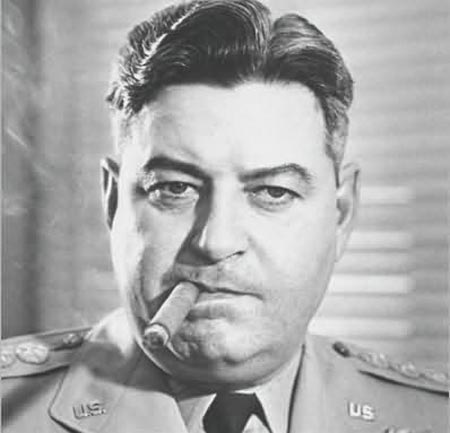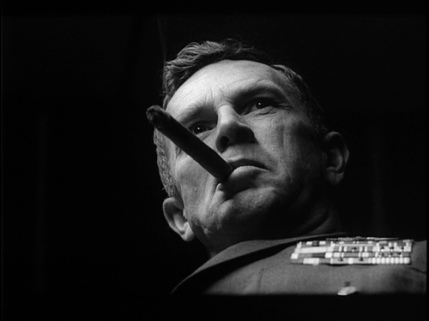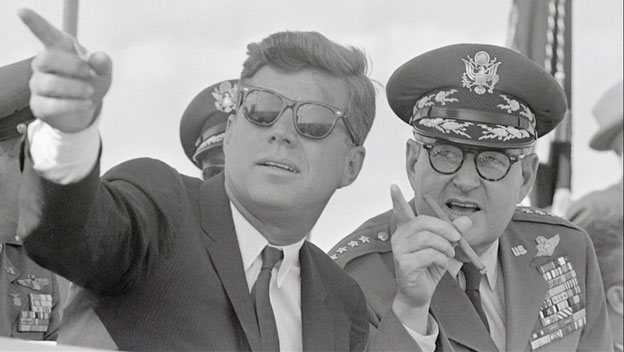
The crisis on the Korean peninsula has highlighted the precarious and dangerous nature of dealing with nuclear weapons. Throughout the Cold War, America lived under a nuclear threat that could ratchet up under the slightest provocation. Fortunately, the lessons learned have helped avoid a catastrophic situation, thus far.
This wasn’t the case in the early post-World War II years. Pre-emptive nuclear strikes were seen as a reasonable deterrence strategy, especially by Air Force General Curtis E. LeMay.
LeMay, known as “Old Iron Pants,” remains a controversial figure in American military history. As a gruff, hard-charging general, he embodied the caricature of a seasoned Cold War military man who acted strongly and decisively against encroaching communist aggression. In Stanley Kubrick’s film Dr. Strangelove, LeMay was the inspiration behind General Jack D. Ripper, a deranged base commander hellbent on destroying the Soviets.
LeMay’s strategic leadership in aerial bombardment helped halt Nazi Germany, while his tactics in Japan assisted in bringing the war to an end. During the Cold War, his big personality and his aggressive military approach pushed America to the brink of conflict.
“We should always avoid armed conflict. But if you get in it, get in with both feet and get out as soon as possible,” said LeMay, who believed a single knockout blow to the enemy was a humane war strategy.
“Apply whatever force it is necessary to employ, to stop things quickly. The main thing is stop it. The quicker you stop it, the more lives you save.”
Born in Columbus, Ohio, in 1906, LeMay graduated with a degree in civil engineering from the Ohio State University before earning a commission in the Army Air Corps. In 1943, he personally lead dangerous bombing raids over Germany, before moving to the Pacific where he increased target accuracy with low-altitude bombing. LeMay’s innovation had deadly results. As the commander of all B-29 combat operations, he was the architect behind the firebombing of Tokyo, which had mostly wooden homes. In one night in 1945, his bombing run killed more than 100,000 people, and more than 500,000 before the end of the war.

“Killing Japanese didn’t bother me very much at that time… I suppose if I had lost the war, I would have been tried as a war criminal…. Every soldier thinks something of the moral aspects of what he is doing. But all war is immoral and if you let that bother you, you’re not a good soldier,” LeMay said in his autobiography.
After America developed the nuclear bomb, LeMay helped plan the drop over Hiroshima. He proposed a single aircraft, the Enola Gay, would draw less attention. The Japanese were so devastated by LeMay’s firebombing campaign, everyone assumed it was a reconnaissance plane and left it alone.
Following the war, LeMay lead the Berlin Airlift in 1948. The Air Force flew more than 500 tons of supplies daily over an eleven month span after the Soviets closed the corridor leading to West Berlin. A year later, LeMay traveled back to the United States and became the first commander of the Strategic Air Command in Nebraska. After the Soviets obtained nuclear weapons, LeMay helped SAC develop new aerial strategies and tactics for seemingly imminent nuclear war.

In addition to developing a war plan that called for dropping 133 nuclear bombs on 77 Russian cities, LeMay turned his squadron into a prepared force ready to rain nuclear holocaust on the world within minutes. Based on LeMay’s military theory, the only way to ensure survival was through preemptive action. The belief in a swift and decisive nuclear strike fueled his intensity. From the mid-1950s until 1968, America had at least one bomber in the air carrying an armed nuclear missile. Fortunately, no major accidents occurred, but some embarrassing mishaps forced the military to rethink its deployment of nuclear weapons. The Tybee Island Collision in 1958 jettisoned a 7,000 pound nuclear bomb off the coast of Georgia. The bomb was never recovered.
“We are now living in an age when it can no longer be an issue of morality that a nation must receive the first physical blow before it can respond with force,” LeMay once said to Pentagon officials in 1955.
As an Air Force Chief of Staff under President John F. Kennedy, LeMay was among the most forceful generals in the White House during the Cuban Missile Crisis. Kennedy believed any action against Cuba would result in retaliation towards West Berlin.

“This blockade and political action … will lead right into war,” LeMay warned as the President proposed surrounding the island with the Navy. The other chiefs agreed.
“This is almost as bad as the appeasement at Munich,” LeMay declared. “In other words, you’re in a pretty bad fix at the present time.” His reference to Munich was a direct insult to Kennedy and his father, Joe Kennedy, who served as British ambassador to Britain and supported Neville Chamberlain’s policy of appeasement against Hitler.
Kennedy took offense. “What did you say?”
“You’re in a pretty bad fix,” LeMay replied, refusing to back down.
“You’re in there with me,” said Kennedy. Fortunately, the President’s cautious demeanor prevailed.
During the Vietnam War, LeMay lobbied Defense Secretary Robert McNamara and President Lyndon Johnson for a sustained bombing campaign in North Vietnam. His continued requests to remove limits on bombing, as well as a quote saying “we should bomb them back to the stone age,” ultimately lead to his forced retirement from the Air Force in 1965.
Three years later, he served as segreationist George Wallace’s running mate in the 1968 presidential election in an attempt to steer votes away from Richard Nixon.
LeMay died in California in 1990. However, his impact on nuclear defense policy has undoubtedly helped shape our current thinking on the issue.